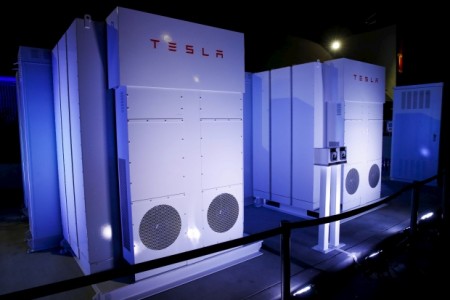May 1, 2015 – Time to come clean. A few days ago I wrote a sneak preview of Tesla’s upcoming announcement about a home battery to use with solar rooftop panels. Well I couldn’t have gotten my information more wrong.
The announcement yesterday of what is called the Powerwall is a home battery which will sell for $3,000 U.S. for the 7 Kilowatt-hour and $3,500 for the 10 Kilowatt-hour models. The price excludes the inverter and installation cost and are the ones Tesla has announced for solar power companies and installers, not home users. If you need more power than a single 10 Kilowatt-hour model you can install multiple Powerwalls together.
The $13,000 price mentioned in my previous posting was way off the mark although it more closely resembled prototypes which were originally priced during product testing. In fact, a prototype price of $18,300 less state incentives which brought the price down to $7,500 is mentioned in an article appearing in CBC News. So that is my mea culpa for overstating the price.
Tesla hopes to start selling Powerwalls this summer and launch internationally in 2016. Distribution will be through SolarCity, one of Elon Musk‘s companies, as well as Amazon, Target and the utility, Southern California Edison. No mention of Wal-Mart or Cargill as customers. Got that wrong too!
Powerwall is very much the evolution of the lithium-ion technology currently used by Tesla automobiles. But added to the battery technology are a liquid thermal control system and solar inverter software to manage the device. Meant to be wall-mounted, hence Powerwall, it will capable of operating both off and on the grid. It will when attached to the grid feed excess energy back to power utilities. The 10 Kilowatt-hour model is capable of providing backup should a break occur in power from the grid at anytime. The 7-Kilowatt hour model is designed to provide enough stored energy for 24×7 power to a house after its rooftop solar panels shut down for the night.
The announcement by Tesla also included another product called Powerpacks. Two versions will be available. The first for business so that a plant or office can run independent of the grid if needed, and the second for energy utilities. Musk during the announcement stated that with 160 million Powerpacks he could transition the entire United States to renewable energy. His plans to build the world’s largest Gigafactory to manufacture batteries in Nevada represents the first stage in achieving that goal. He intends to build several more and hinted that other companies in cooperation with Tesla will be manufacturing storage batteries to make that transition a reality.
Each Powerwall will come with a ten-year warranty and option for an additional ten-year extension. The battery is designed to operate in temperatures ranging from -20 Celsius (-4 Fahrenheit) to 43 Celsius (110 Fahrenheit). Weight 100 kilograms (220 pounds). Height 1.3 meters (51.2 inches). Width 0.86 meters (33.9 inches) and depth 18 centimeters (7.1 inches).
If you are thinking about installing a Powerwall in your home here is some helpful data on common household electricity usage so you can calculate which model is best suited for your needs.
A flat screen television draws 0.1 Kilowatt-hours of energy.
A refrigerator 0.2 Kilowatt-hours.
Lights per room draw 0.1 Kilowatt-hours.
A laptop draws 0.05 Kilowatt-hours.
A washing machine draws 2.3 Kilowatt-hours each usage.
A clothes dryer draws 3.3 Kilowatt-hours per usage.
And a Tesla Model S sedan draws 4.5 Kilowatt-hours when charging.



















Hi Len,
I am curious. While the benefit of the technology from an alternative, renewable energy perspective is clear what about the implications of the impact of lithium mining and eventual disposal on the environment?
Disposing of lithium will present a future problem. We don’t know what the rated cycles are for the Powerwall. How many recharges before the batteries lose their ability to hold a charge? Tesla will have to address these issues and develop a recycling system which hopefully reprocesses the lithium for re-use.
But my best guess is that lithium will be replaced by aluminum and sulphur-based battery technology within the next 3 to 5 years. These materials would be less of an environmental issue than lithium.
Though this is set up for solar use, I think that an equally valuable use of these batteries would be in load leveling. This is a topic that you’ve discussed before Len, but with this price point, it could easily fit into a homeowner budget and draw power at low cost times, for use in high cost times. It might even be in the local utilities interest to deploy these to their customers.
As a bonus, it also adds a bit of backup in the event of power outages.
SP
I can see if adopted by utilities as a service to customers that load leveling would be a very desirable feature.